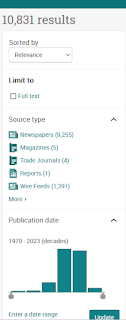Here's a round-up of recent articles that the staff of the SFPL
Magazines and Newspapers Center are reading. Access options for the
articles are linked through the library's subscriptions–use your library card to read for free.
__________________________________
Vogue, December 2023
Nicki
Minaj dons the cover of this month's Vogue magazine, who says of the
rapper, "On the eve of releasing a new album, Nicki Minaj is in a
contemplative mood, thinking about marriage, motherhood, alter egos,
creativity, and confidence." Decked out in seven designer outfits for
the accompanying photoshoot, Minaj sparkles as a mature woman embracing
the beauty of self-acceptance and luxuriating in her identity as a parent. Get every new issue of Vogue on the platform Flipster through SFPL.
__________________________________
Wallpaper* Magazine, November 2023
This design magazine coming out of England, which we have available on the PressReader eMagazine platform, ran an in-depth piece on the artist currently featured at San Francisco's own Asian Art Museum: the hyper pop artist Takashi Murakami. It's fun to see a publication from across the pond reporting on something happening just across Fulton Street.
__________________________________
New York Times, December 18, 2023
Magazines and newspapers spring organically from any community as a necessary means of communication; the more constrained, the more likely the community to produce a periodic publication. Internment camps, prisons, colleges... all have needs for an inside beat. Curt Bloch, a German Jew who hid in a Dutch family's attic for five years during WWII and the holocaust, made a magazine for the two people with whom he hid, his hiding helpers, and potentially more Jews in hiding through the undercover network in the Netherlands. Only recently has the wider world known about these magazines, and a new exhibit featuring each issue will open in Berlin in February, 2024.
*Update 10 Jan 2024: SFPL Book Arts and Special Collections has acquired Bloch's Underwater Cabaret!
__________________________________
Harper's Magazine, January 1996
David Foster Wallace, the late author of the novel Infinite Jest who has achieved a cult-like following postmortem, wrote this essay for Harper's about a 1995 spring break cruise in the Caribbean that the magazine sent him on. He didn't really want to go, and applied his sharp critical eye to the entire experience. The story was revived recently by the good-news site The Attic and piqued our curiosity for the original essay. Surely you can do a general web search to find a PDF of the piece as it appeared in Harper's, but you can also click the link above to get the article through SFPL's subscriptions. We have Harper's Magazine available through many databases as well as in print and on microfilm.
__________________________________
Harper's Magazine, May 2023
You can't mention DFW's iconic 90s cruise piece without mentioning Lauren Oyler's 2023 companion cruise piece that engages with and tries to avoid the tropes Wallace popularized. Launched like an alarming takedown of the wellness industry's fake feminism vis-à-vis Wallace's pop culture takedown, Oyler's essay succeeds in using the cruise for unjoyous fodder to the same extent DFW's essay did: rebuke joyousness. To be honest, Oyler's confessional mode about her two boyfriends and their drug usage does more to draw in a reader than her scathing evaluation of Goop's ridiculousness. Sure you can read the piece for free on the open web, but SFPL has you covered if that link ever expires (see link in title, above, for SFPL access).
__________________________________
















.png)











